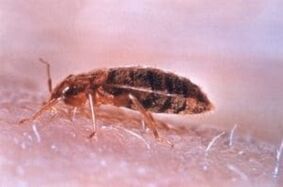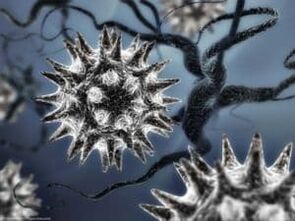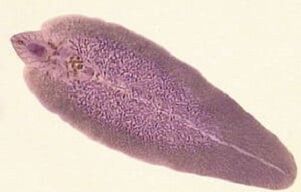Given the ways in which parasites enter the body, it is possible to take preventive measures about possible sources of infection. What helminths as intestinal parasites are known to many. However, the common man is less familiar with the species that live in the circulatory system, subcutaneous lymph, muscles, brain, and internal organs.
All types of parasites in the human body are classified into representative groups: protozoa, flat and round worms, arthropods, and larvae.Viruses, pathogenic bacteria, and fungi can be classified as parasites, but can be classified into separate groups. Infectious diseases can be divided into viral, fungal, bacterial and parasitic. The classification of human parasites includes - a unique fish species (common vandellia) that can penetrate the human urethra (random host).
Parasitism and its types

Who are the parasites? These are organisms that live at the expense of another individual, are not genetically related to him, and enter into antagonistic relationships, i. e. , disrupt life. The concept of parasitism should not be extrapolated to microorganisms living inside the body without causing particular harm to it. There are plant and animal parasites in nature, depending on the type of host. During the operation of this lifestyle, the parasite and the host system operate continuously. The task of the first is to live from the second without killing it for a long time.
Classification of parasites by type:
- Localization sites: external and internal parasites (exo- and endoparasites).
- Through life: constantly parasitic (mandatory) and free-living forms that, under certain circumstances, begin to exist at the expense of another organism (optional parasites).
- Timing of contact with the host: temporary and permanent parasites (stationary and periodic).
In the food chain, animal parasites are usually second- or third-order consumers because they feed on herbivores or carnivores. The parasite's diet lacks many nutrients and / or leads to cell and tissue destruction. Host antagonism often occurs because dangerous residents release toxic metabolites. This leads to certain symptoms (allergies, gastrointestinal disorders, signs of damage to various internal organs).
Viruses

Viruses are intracellular parasites with a protein-genetic structure. They multiply themselves because of the cellular materials. The virus is a mandatory parasite.
Depending on the type of genetic material, viruses containing RNA and DNA are isolated. The intracellular drugs of the first group are:
- Enteroviruses. They multiply in the digestive system, causing problems in various human organs.
- Rhinoviruses. Pathogens of ARVI.
- Influenza, rabies and tick-borne encephalitis viruses.
- Papillomaviruses.
The second group includes: adenoviruses (causing acute respiratory infections), herpes and smallpox pathogens.
Viruses, once in the target cell, subordinate themselves to their processes, integrate into the genetic material or localize in the cytoplasm, and then multiply (multiply). Cell death then occurs due to lysis, apoptosis, or distortion of membrane structure. Some members (papillomaviruses, Epstein-Barr virus) are able to cause degeneration of cells into malignancy.
How viruses get inside:
- Aerial.
- Through the gastrointestinal tract when drinking water and eating food.
- Through the skin and external mucous membranes, such as the conjunctiva of the eye.
- Using arthropod vectors (insects, ticks).
- As a result of the use of non-sterile medical devices (syringes, pipettes).
Each virus targets a specific cell, distinguishing receptors from the target.
Bacteria

Among the bacteria, rickettsiae, intracellular parasites occupy a special place. These are the most primitive representatives that resemble viruses. In humans, these microorganisms cause: typhus, tick-borne rickettsiae, Rocky Mountains spotted fever. People become infected with rickettsia by biting ticks, fleas, lice.
Other intracellular parasites of chlamydia cause one of the most common sexually transmitted diseases (chlamydia) and cause severe eye inflammation, pneumonia in infants, and enteritis.
Dangerous bacteria:
- Salmonella is the cause of typhus.
- Tetanus rod.
- Pale spirochete that causes syphilis due to a difficult diagnosis of the disease, which delays treatment.
- Pneumococcus, which can cause pneumonia and, less commonly, bacterial meningitis.
- Tuberculosis is a bacillus that cannot manifest for a long time and then turns into an open form.
- Escherichia coli as it is capable of antibiotic resistance. It causes gastroenteritis, rarely meningitis and urinary tract infection.
External parasites, such as Staphylococcus aureus, are known to cause a variety of skin infections. The most dangerous consequences of its activity are pneumonia, meningitis, osteomyelitis, endocarditis, severe shock due to exposure to bacterial toxins and sepsis (called sepsis in everyday life).
Mushroom

Disease-causing fungi - human parasites are better protected from the effects of drugs than bacteria. The most common fungal disease is candidiasis (thrush), which is localized on various mucous membranes with a weakened immune system. Fungi of the genus Candida live in the body of all healthy people and only cause tangible damage if the protective function does not work. Conditionally pathogenic bacteria and fungi form the boundary group of microorganisms between the non-pathogenic and pathogenic categories. Therefore, they do not generally qualify as parasites.
Pathogenic micellar fungi are human parasites that often cause diseases of the external integument:
- Keratomycosis. Fungi multiply in the keratinized zone of the epidermis or on hair follicles (trichosporia nodosum, versicolor versicolor).
- Dermatophytosis. Pathogens affect not only the epidermis but also the dermis, nails and hair (ringworm, scarring).
- Deep mycoses. Damage to the skin and nearby tissues as well as internal organs. These include histoplasmosis - a severe systemic fungal disease and aspergillosis - mucous membranes and skin damage caused by aspergillus.
The classic source of bacterial and fungal infections are sick people, animals, soil, dirty water and food.
Protozoa
Protozoa are another unicellular parasite of bacteria and fungi. What protozoan parasites are isolated from a person as a function of the systematic situation?
- Certain types of amoebas are optional parasites. The most famous is dysentery amoeba, which enters the human body in the form of a cyst (resting form). The pathogen enters the colon (luminal form), then penetrates the mucous membranes and affects the various internal organs with the bloodstream. Amoebae are aquatic organisms, so the main source of infection with them is dirty water. Acanthamoeba keratitis is a rare eye disease called acanthamoeba keratitis that has become more common due to the growing popularity of contact lenses.
- Flagellates (Leishmania, Giardia, Trichomonas). Trichomoniasis is the most common disease of the urogenital system and is dangerous due to its complications (infertility, prostatitis, preterm birth, etc. ).
- Apicomplexes (sporozoa). With the exception of colpodellids, only the obligatory parasites (Toxoplasma, Plasmodium malaria, Cryptosporidium, Coccidia, sarcocysts) belong to the group. Sporozoa cysts enter the body after biting insects, consuming infected animals, or drinking water.
- Ciliates. In humans, balantidia is dangerous, causing diarrhea and ulcers in the intestinal wall as a result of colonic activity. Silylates are the largest pathogens of unicellular organisms.
The simplest human parasites cause protozoan infections (protozoa). What parasites live in the human nervous system among protozoa? For example, the pathogens of toxoplasmosis and cerebral malaria. Among the amoebas, the optional parasite Neglerius Fowler can infect the nervous system.
Multicellular
Multicellular parasites include flatworms, roundworms, arachnids, and insects. The former usually settle inside a person (in various systems and internal organs) and certain species migrate or invade the subcutaneous layer (rishta, larvae of Gnathostoma spinigerum and hookworms, schistosomes). Worms are the collective name for all worms that cause helminthic infections (helminthiasis).
Common diseases caused by flatworms
Group of trematodes (digenetic spots):
- Opisthorchiasis. Pathogens: Types of liver layers such as feline and Siberian fluke. Infection occurs as a result of consuming infected river fish, poorly processed thermally.
- Fascioliasis. Caused by liver and giant spots. Infection is caused by consuming contaminated water or coastal grass.
- Schistosomiasis. The pathogens of schistosomes (especially blood clots) live mainly in hot climates. They penetrate the skin in contact with water.
- Paragonimiasis. The cause of the disease is a lung peak that is found in hot climates. Worm-infected and poorly processed thermal freshwater crayfish or crabs are dangerous.

The life cycle of a parasite belonging to the group of trematodes is complex, including several larval stages and abdominal legs as intermediate carriers. Fluk are animal parasites of vertebrates, acting as temporary and permanent hosts. Sections of individual larvae are able to develop without fertilization. Flukes devices are suction to secure and feed the farmer.
Tapeworms are mandatory parasites of the human small intestine. Their bodies are made up of segments (proglottids) that break off periodically and come out with the fertilized eggs. The life-cycle stages of tapeworms necessarily include the finnish (vesicular worm), which is formed as a temporary owner. The permanent recipient swallows the Finnish, which develops into a conical (adult) form. The structural features of tapeworms are lack of digestive system and absorption of nutrients over the entire surface.
Most common:
- Bovine tapeworm (unarmed tapeworm) causes teniarinhoses disease. The infection occurs through the meat of cattle, whose muscles are thought to be Finnish and which developed in the body after the animals swallowed the eggs.
- Swine tapeworm (armed tapeworm) is a pathogen of cysticercosis (Finnish stage) and teniasis (adult). In addition to the suckers, the helminth is provided with a rim of hooks. A person can act as both an intermediate and a permanent owner at the same time.
- Wide tapeworm causes diphyllobothriasis. Intermediate hosts are kopepods and fish. A person can become infected with insufficient salted caviar and poorly cooked or fried freshwater fish.
Parasites feed on blood and tissues (flukes) or digested food (tapeworms).
Roundworms
What types of parasites occur in humans among roundworms (nematodes)?

- Ascaris. Ascariasis includes the migratory (larval) and intestinal (adult) stages. The larva penetrates the wall of the small intestine, passes into the lungs, bypassing the liver and heart, passing through the molten sections one after the other. It enters the oral cavity, swallows again, and becomes an adult in the small intestine.
- Pinworm. The pathogen of enterobiasis feeds in the final and initial zone of the small and large intestine, multiplying in the ileum. Females lay in the folds of the rectum, causing severe itching.
- Vlasoglav is the cause of trichocephalosis. These parasites in the human body penetrate the mucous membranes of the initial stage of the colon and feed on tissue fluid and blood.
- Trichinella is a dangerous disease of trichinosis. In severe cases, the nervous system is damaged. These are real killers whose larvae penetrate the wall of the small intestine and can be carried throughout the body. They mostly get into the striated muscles, they can penetrate the eyes, causing pain and swelling of the face in the lungs, leading to coughing. No drug has been found so far for complete recovery.
- Toksokara. A distinction should be made between larval (more common) and imaginary (intestinal) toxocariasis. Invasion is characterized by the severity of allergic reactions. The larvae spread throughout the body, entering the tissues, encapsulating to form granulomas.
- Hookworms are more common in the tropics and subtropics. In hookworm infection, the worms in the intestines secrete proteolytic enzymes that destroy the walls and reduce blood clotting. Parasites appear inside humans as a result of larvae entering the skin from contaminated water.
- Escherichia coli and related species are tropical parasites. The disease they cause, strongyloidosis, can be asymptomatic for decades. In case of reduced immunity, worm carriers are at high risk (60-85%).
- Rishta is a subtropical helminth that causes dracunculiasis. The larvae penetrate the intestinal wall. The females reach the subcutaneous layer and when the host is in the water, they expel the larvae through the skin. The temporary farmer has a copepoda cancer.
The habitat characteristics of parasites affect the way they get into the body: they are inhabited by contact with contaminated water or soil, and by larval carriers. Many representatives of roundworms have no intermediate hosts and belong to the geohelminths. Infection with them occurs mainly through contaminated water, unwashed hands, fruits or vegetables, and by consuming wildlife meat.
Treatment of helminthiasis and its serious consequences
One important way to diagnose helminthiasis is with a blood test. Eosinophils (a type of white blood cell) that are found in high concentrations, along with other signs of infection, indicate the presence of a worm and a number of pathogenic protozoa in the body. How are helminthiasis treated? Medications are used to relieve symptoms and provide specific treatment. Antiallergic (desensitizing) and detoxifying therapy is used. Basically, the drugs are given by infusion (drip), sometimes with injections:
- A drug that replaces plasma and removes the effects of toxins.
- Isotonic glucose solution and saline.
- Vitamins C and B6.
- Sodium bicarbonate (soda), calcium chloride or gluconate.
- High temperature preparations.
- Hormonal medications are used in difficult situations (hepatitis or allergic myocarditis). Potassium intake is combined with them.
- Medications for heart failure and edema.
There is evidence that certain parasitic worms, such as the dwarf tapeworm, can cause cancer. The larval stem cells can degenerate into cancer cells. Parasites can indirectly cause cancer by weakening the immune system. Interesting data were obtained when studying the effect of liver trematodes. Due to exposure to waste generation, ordinary cells can become cancer cells. Parasites are primarily localized in the digestive system, but their larvae are able to penetrate various internal organs. For example, in the kidneys (echinococcosis, schistosomiasis), in the heart muscle (cysticercosis, hookworm disease), in the liver (echinococcosis). Parasitic worms in humans often affect the nervous system. The brain is known as cysticercosis, echinococcosis, alveococcosis and schistosomiasis.
Arthropods
The order of insects includes well-known ectoparasites such as fleas, bugs, and blood-sucking dipterans. Unlike lice, they are temporary parasites, meaning they live permanently with the help of the host. Arachnid parasites of the arachnid order include the well-known ryegrass. The mating of the male and the female takes place on the surface of the epithelium. Parasites in the human body then lay their eggs in the keratin layer of the skin, causing severe itching. Many people know what an ixodid tick is. These are arthropod parasites from the order of arachnids, including the most famous representative of the taiga tick - a carrier of dangerous infections (tick-borne encephalitis, Lyme disease). Among the blood-sucking dipterans are: non-malaria and malaria mosquitoes, mosquitoes, mid-sinkers, biting midwives, horse moths, and real flies. These arthropod parasites can cause a strong allergic reaction and are also carriers of dangerous viral and bacterial infections. Some flies, especially flycatchers, lay larvae under human skin, causing myiasis. The larvae are able to penetrate the body.






































